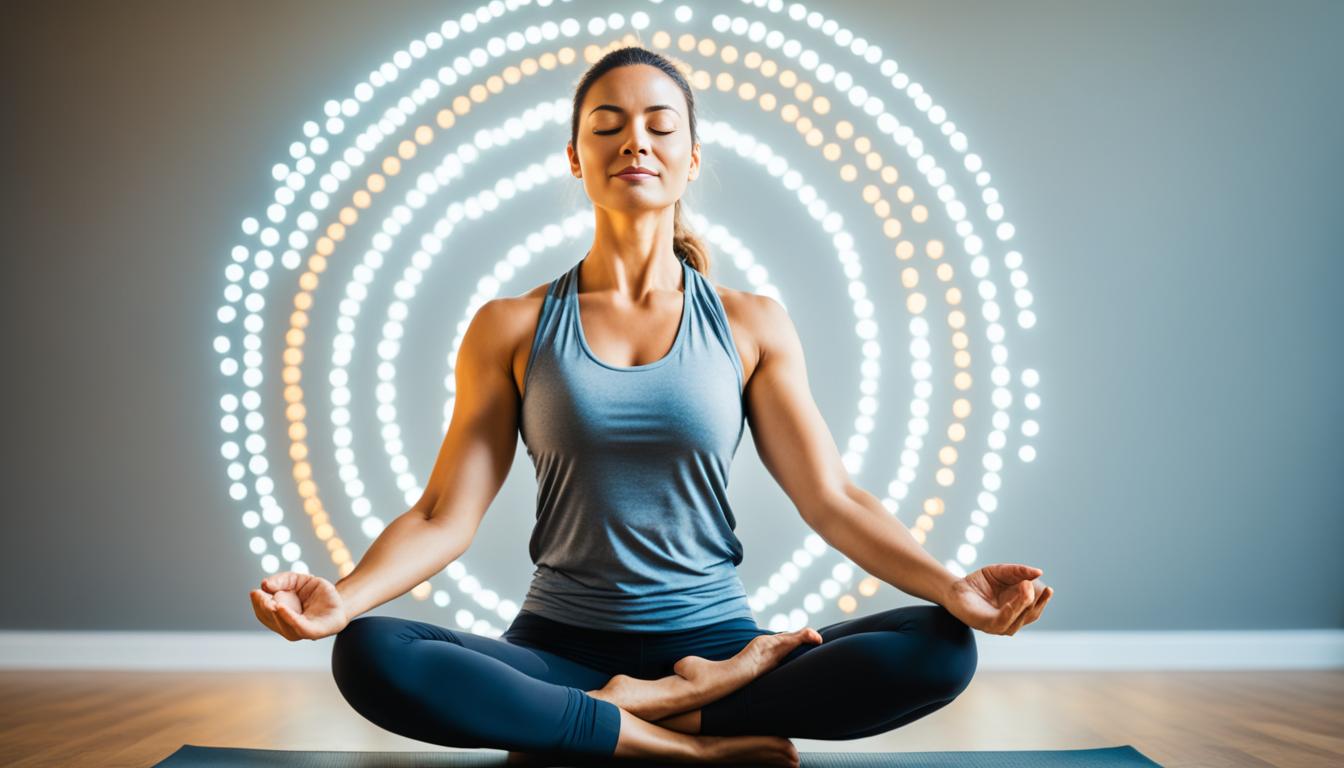Disclosure: This Post Contains Affiliate Links; We earn a commission on purchases.
Discover the transformative powers of yoga and meditation for your mind and body. The concept of mind/body dualism explores the intricate connection between our thoughts and physical well-being. In this section, we will delve into the historical background of mind/body dualism, and how yoga and meditation can bridge the gap between the mind and body to promote holistic health and wellness.
Key Takeaways:
- Mind/body dualism explores the relationship between our thoughts and physical selves.
- Yoga and meditation act as powerful tools in enhancing the mind-body connection.
- Yoga improves physical well-being and cultivates a deeper connection between the mind and body.
- Meditation guides the journey towards mind/body integration, cultivating mindfulness and awareness.
- Scientific studies validate the profound impact of meditation on the mind/body connection.
Exploring the Concept of Mind/Body Dualism
Mind/body dualism is a concept that delves into the relationship between our thoughts and our physical selves. This philosophical idea finds its origins in ancient Greece, with renowned philosopher Plato proposing the notion of an immortal soul separate from the mortal body. Over the centuries, various perspectives on mind/body dualism have emerged, with some considering the mind as a product of the brain, while others believe in a transcendent consciousness beyond the physical realm.
“The greatest wealth is to live content with little, for there is never want where the mind is satisfied.” – Plato
Plato, one of the most influential philosophers in ancient Greece, argued that the soul is eternal and separate from the physical body. He believed in the immortality of the soul, viewing it as the true essence of a person’s being. Plato’s teachings laid the groundwork for understanding mind/body dualism and the existence of consciousness beyond the limitations of the material world.
This concept of mind/body dualism continues to be an intriguing topic of discussion among philosophers and scholars alike. While some argue that the mind is simply a product of neural activity within the brain, others see consciousness as a distinct and independent entity that transcends physical existence.
As our understanding of the human mind and body continues to evolve, exploring mind/body dualism provides valuable insight into the intricate nature of our existence and the interplay between consciousness and physicality.
| Ancient Greece | Mind/Body Dualism |
|---|---|
| Originates in ancient Greece with philosophers like Plato | Explores the relationship between thoughts and physical selves |
| Soul viewed as immortal and separate from the body | Various perspectives on the existence of mind and consciousness |
| Concept continues to be a topic of philosophical debate | Understanding the nature of consciousness and its relationship to the physical world |
The Role of Yoga in Bridging Mind and Body
Yoga is not only beneficial for physical well-being but also plays a significant role in bridging the gap between the mind and body. Regular yoga practice improves flexibility, strength, and balance, promoting physical health and vitality. But its benefits go beyond the physical realm.
The mindful nature of yoga cultivates a deeper connection between the mind and body, fostering a sense of harmony and holistic healing. Through yoga, practitioners are encouraged to bring their awareness to the present moment, creating a state of mindfulness that allows them to fully inhabit their bodies and experience a deeper level of self-discovery.
By focusing on breath awareness and engaging in mindful movement through yoga poses, individuals develop a heightened sense of body awareness. This heightened awareness enables them to recognize and release physical and emotional tension, allowing for a more integrated and balanced state of being.
“Yoga is the journey of the self, through the self, to the self.” – The Bhagavad Gita
Yoga serves as a powerful tool for self-exploration and self-expression. It offers a space for individuals to cultivate a deeper understanding of themselves, their bodies, and their emotions. Through regular yoga practice, individuals develop a greater sense of inner strength and resilience, empowering them to navigate life’s challenges with grace and equanimity.

The physical postures, breath awareness, and mindfulness cultivated in yoga create a unique synergy between the mind and body. This integration allows individuals to tap into their innate healing abilities and experience a profound sense of well-being. Yoga becomes a gateway to holistic healing, fostering a deeper connection with the self and promoting overall physical, mental, and emotional wellness.
Benefits of Yoga for Physical Well-being:
- Improved flexibility, strength, and balance
- Enhanced body awareness and posture
- Increased energy and vitality
- Stress reduction and relaxation
- Promotes better sleep
- Boosts immune system function
Incorporating yoga into a regular wellness routine helps individuals create space for self-care and nourishment. It provides an opportunity for individuals to reconnect with their bodies, cultivate mindfulness, and discover their unique and authentic selves.
Meditation as a Tool for Mind/Body Integration
Meditation serves as an invaluable tool in the journey of mind/body integration. Through various techniques, meditation allows us to cultivate mindfulness, presence, and a harmonious relationship between our thoughts and bodily sensations. By devoting time to regular meditation practice, we can foster a deep and profound connection within ourselves.
One type of meditation that enhances the mind/body connection is focused attention meditation. This practice involves directing our focus to a single point, such as the breath or a specific sensation. By honing our attention and becoming fully present in the moment, we develop a heightened awareness of the mind/body connection.
Loving-kindness meditation is another powerful technique that nurtures the mind/body connection. This practice involves cultivating feelings of love, compassion, and kindness towards ourselves and others. By extending kindness to ourselves, we strengthen our inner connection and enhance our overall well-being.
“Meditation is not a way of making your mind quiet. It is a way of entering into the quiet that is already there – buried under the 50,000 thoughts the average person thinks every day.” – Deepak Chopra
During meditation, we create a space where our inner wisdom can emerge, allowing us to become more attuned to our thoughts, emotions, and physical sensations. This heightened awareness brings us a sense of peace, clarity, and inner connection.
Through the practice of meditation, we develop the ability to observe our thoughts and emotions without judgment. This non-judgmental awareness enables us to cultivate acceptance and understanding, fostering a stronger mind/body connection.
The Benefits of Meditation for Mind/Body Integration
| Benefits | Description |
|---|---|
| Enhanced Presence | Meditation heightens our ability to be fully present in the moment, allowing us to experience a deeper connection between our mind and body. |
| Improved Awareness | Meditation cultivates a heightened awareness of our thoughts, emotions, and physical sensations, enabling us to develop a stronger mind/body connection. |
| Inner Peace | Regular meditation practice brings a sense of peace and tranquility to our lives, promoting a harmonious relationship between the mind and body. |
| Clarity of Mind | Meditation helps to clear the mind of clutter and distractions, allowing us to gain clarity and insight into the mind/body connection. |
| Deep Inner Connection | Through meditation, we strengthen our inner connection and cultivate a profound sense of self-awareness, fostering an integrated mind/body existence. |
By incorporating meditation into our daily lives, we can experience the transformative power it holds in deepening our mind/body connection. The peace, clarity, and inner connection cultivated through meditation create a firm foundation for a balanced and fulfilling life.
The Science Behind Meditation and Mind/Body Connection
Scientific studies have provided compelling evidence for the numerous benefits of regular meditation practice on the mind and body. Meditation, a practice rooted in ancient traditions, has been shown to have a profound impact on various aspects of our well-being, including emotional regulation, cognitive function, stress reduction, and the activation of the parasympathetic nervous system.
The Impact on Emotions
Meditation has been found to be highly effective in regulating and managing emotions. Through mindfulness meditation, individuals learn to cultivate a non-judgmental awareness and acceptance of their emotions, allowing them to observe and understand their feelings without being overwhelmed by them. This mindfulness-based approach empowers individuals to navigate through challenging emotions, promoting emotional balance and resilience.
Enhanced Cognitive Function
Regular meditation practice has demonstrated positive effects on cognitive function. Studies have shown that meditation can improve attention, focus, and memory. By training the mind to remain present and focused during meditation, individuals can transfer these skills to their daily lives, leading to increased mental clarity and improved cognitive performance.
Reduced Stress Levels
Meditation is a powerful tool for stress reduction. By activating the body’s relaxation response, meditation helps to counter the effects of chronic stress and promotes a state of calm and tranquility. Regular meditation practice has been shown to decrease levels of stress hormones such as cortisol, leading to a decrease in anxiety and an overall sense of well-being.
The Role of the Parasympathetic Nervous System
The parasympathetic nervous system is responsible for the body’s rest and digest response. It promotes relaxation, decreases heart rate, and lowers blood pressure. Through meditation, individuals can activate the parasympathetic nervous system, allowing the body to enter a state of deep relaxation and facilitating self-healing processes.
Overall, the scientific findings on meditation highlight its potential to strengthen the mind/body connection and promote holistic well-being. By incorporating regular meditation practice into our lives, we can experience the transformative benefits it offers for our emotional and cognitive health, stress reduction, and activation of the parasympathetic nervous system.
The Interplay Between Yoga, Meditation, and Mind/Body Dualism
Yoga and meditation are intertwined practices that complement each other in achieving mind/body integration. By incorporating these two powerful modalities into our lives, we can delve deeper into the mind/body connection and experience profound transformation.
Yoga serves as a foundation for the practice of meditation by preparing the body for stillness and focus. Through physical postures, breath awareness, and mindful movement, yoga releases tension and opens energetic pathways. This prepares both the body and mind for the practice of meditation, creating a fertile ground for immersing oneself in introspection and self-discovery.
“Yoga is the journey of the self, through the self, to the self.” – Bhagavad Gita
Meditation, on the other hand, enhances the yoga practice by cultivating a focused and calm state of mind. The practice of mindfulness during meditation enables a deeper level of presence and awareness, allowing us to connect more fully with our body and its sensations.
Whether it’s holding a yoga pose or sitting in stillness during meditation, both practices emphasize the importance of being present in the moment. This presence brings us into closer alignment with the mind/body connection, fostering a sense of centeredness and unity.
Together, yoga and meditation offer a holistic approach to mind/body integration. Through the combined practice of physical postures, breath awareness, and mindfulness, we can bridge the gap between our thoughts and physical sensations, leading to a greater sense of well-being and overall balance.
Benefits of the Interplay Between Yoga and Meditation:
- Enhanced mind/body connection
- Improved physical and mental well-being
- Greater self-awareness and self-acceptance
- Reduced stress and anxiety
- Increased focus and concentration
- Heightened sense of presence and mindfulness
The interplay between yoga, meditation, and mind/body dualism opens up a path towards self-discovery and a deeper understanding of our inner selves. Cultivating a harmonious relationship between the mind and body allows us to live more fully and authentically, embracing the transformative power of the mind/body connection.

Achieving Balance and Harmony Through Yoga and Meditation
By embracing the symbiotic relationship between yoga and meditation, we embark on a transformative journey of balance and harmony. These practices guide us toward an integrated existence where the mind and body are no longer separate entities but an interconnected whole. Regular practice of yoga and meditation allows us to tap into the limitless potential of mind-body unity.
Yoga and meditation, when combined, create a powerful synergy that promotes balance and harmony in our lives. Yoga, with its physical postures and breath awareness, brings attention to the body’s sensations and cultivates a sense of balance. Meditation, on the other hand, deepens our awareness of the mind-body connection and helps us find inner peace.
The practice of yoga provides a strong foundation for meditation. As we flow through yoga poses and focus on our breath, we develop a heightened sense of mindfulness and presence. This state of mindfulness becomes the bridge that connects the mind and body, allowing for a deeper exploration of our inner selves.
Meditation, in turn, enhances the benefits of yoga by bringing a calm and centered state of mind into our practice. By cultivating a meditative state during yoga, we are able to deepen our mind-body connection even further. This integration of yoga and meditation allows us to experience a harmonious union of our physical and mental aspects.
The Benefits of Balance and Harmony
When we achieve balance and harmony through yoga and meditation, we unlock a multitude of benefits for our overall well-being. Physically, we experience improved flexibility, strength, and coordination. Mentally, we gain clarity, focus, and a sense of calm. Emotionally, we become more resilient and better equipped to handle life’s challenges.
Furthermore, the mind-body unity cultivated through yoga and meditation extends beyond our individual selves. It ripples into our relationships, allowing us to connect with others on a deeper level. This interconnectedness fosters a sense of harmony not only within ourselves but also in our interactions with the world around us.
Embark on Your Journey Towards Balance and Harmony
To begin your journey towards balance and harmony, consider incorporating yoga and meditation into your daily routine. Start with small steps, dedicating as little as 10 minutes each day to these practices. Find a quiet space where you can practice without distractions and allow yourself to fully immerse in the experience.
During your yoga practice, focus on connecting with your breath and being present in each movement. Allow yourself to explore the sensations in your body and find a sense of balance in each posture. As you transition into meditation, bring your heightened awareness from yoga and cultivate a state of deep presence and mindfulness.
As you continue your regular practice of yoga and meditation, you will witness the gradual transformation of your mind-body connection. You will tap into the innate harmony that exists within you, fostering a sense of peace, joy, and fulfillment.
Remember, achieving balance and harmony is a lifelong journey. Embrace the process, be patient with yourself, and allow yourself to grow and evolve along the way. Through a dedicated practice of yoga and meditation, you will find yourself living a more integrated and fulfilled existence.
Practical Tips for Enhancing Mind/Body Connection
Incorporating yoga and meditation into your daily routine can greatly enhance the mind/body connection. Here are some practical tips to help you deepen your practice and cultivate a greater sense of mindfulness and presence:
- Create a dedicated space: Set aside a quiet and comfortable space in your home where you can practice yoga and meditation without distractions. Make this space inviting and serene, filling it with objects that promote relaxation and peace.
- Set a consistent schedule: Establish a regular routine by designating specific times each day for your yoga and meditation practice. Consistency is key in building a deeper mind/body connection.
- Start with gentle yoga: If you’re new to yoga, begin with gentle and beginner-friendly poses to gradually build strength, flexibility, and body awareness. Practice breath awareness and be mindful of how your body feels in each pose.
- Focus on the breath: Incorporate breath awareness into your yoga and meditation practice. Pay attention to the sensation of your breath as it flows in and out, grounding yourself in the present moment.
- Practice mindfulness in daily activities: Extend your mindfulness beyond formal practice by incorporating it into everyday activities. Whether you’re eating, walking, or doing chores, bring your full attention to the present moment, engaging all your senses.
- Cultivate non-judgmental awareness: Approach your yoga and meditation practice with a sense of curiosity and non-judgment. Notice any thoughts or sensations that arise without attaching any value or judgment to them.
- Explore different meditation techniques: Experiment with different types of meditation techniques, such as focused attention or loving-kindness meditation. Find the ones that resonate with you and incorporate them into your practice for a more diverse and enriching experience.
By following these practical tips, you can enhance the mind/body connection and experience the profound benefits of a more integrated and balanced existence. Remember to approach your practice with patience, self-compassion, and an open mind.
Conclusion
The mind-body connection is a fundamental aspect of our overall well-being. Through the transformative practices of yoga and meditation, we have the power to strengthen this connection and cultivate holistic wellness and inner balance. By integrating these practices into our daily lives, we can experience the profound benefits of a harmonious mind-body existence.
Yoga provides a physical and mindful foundation for mind-body integration. Its physical postures, combined with breath awareness and presence, help release tension and open energetic pathways, creating a deeper connection with our bodies. Meditation, on the other hand, acts as a guide in this journey, allowing us to cultivate mindfulness, awareness, and a sense of inner connection. These practices work hand in hand to bridge the gap between the mind and body.
By embracing yoga and meditation as integral parts of our lives, we tap into the limitless potential of the mind-body connection. Through consistent practice, we can find balance, harmony, and a sense of wholeness. The holistic wellness that arises from this integration permeates every aspect of our lives, promoting inner peace, emotional well-being, and a heightened sense of self-awareness.
Begin your journey towards mind-body connection today. Dedicate time each day to engage in yoga and meditation practices. Create a sacred space for yourself where you can fully immerse in these transformative activities. Beyond formal practice, infuse mindfulness into your daily routine with non-judgmental awareness and curiosity. Embrace the profound wisdom of the mind-body connection and unlock the power of holistic wellness and inner balance.
Source Links
- https://www.sportskeeda.com/health-and-fitness/the-benefits-yoga-meditation-mind-body-wellness
- https://www.aurahealth.io/blog/mind-body-dualism-in-yoga-and-meditation
- https://knewhealth.com/mind-body-connection-health-benefits-of-yoga-and-meditation/
Ryan Conlon is a passionate advocate for mindfulness and meditation, dedicated to helping others discover the transformative power of these practices in their lives. As the founder of Daily Meditation, Ryan’s mission is to provide a sanctuary for individuals seeking peace, clarity, and well-being amidst the chaos of modern life. With a background in psychology and years of personal experience with meditation, Ryan brings a wealth of knowledge and insight to his work. Through Daily Meditation, he shares practical guidance, inspirational content, and expert resources to support others on their journey toward greater mindfulness, resilience, and inner peace.
Subscribe to Our Newsletter


















